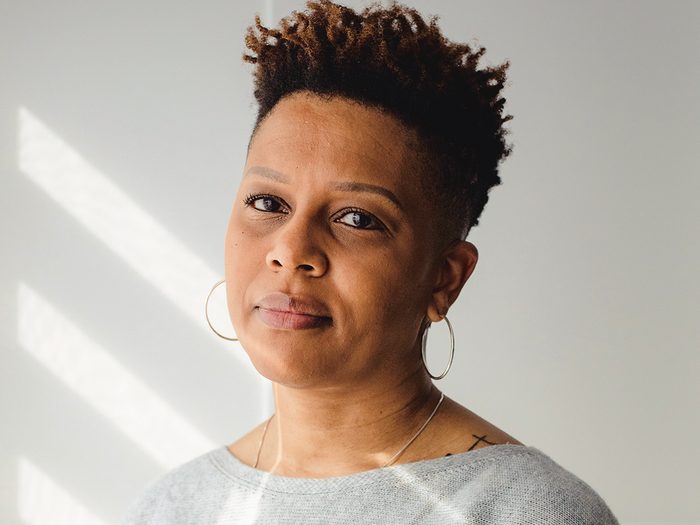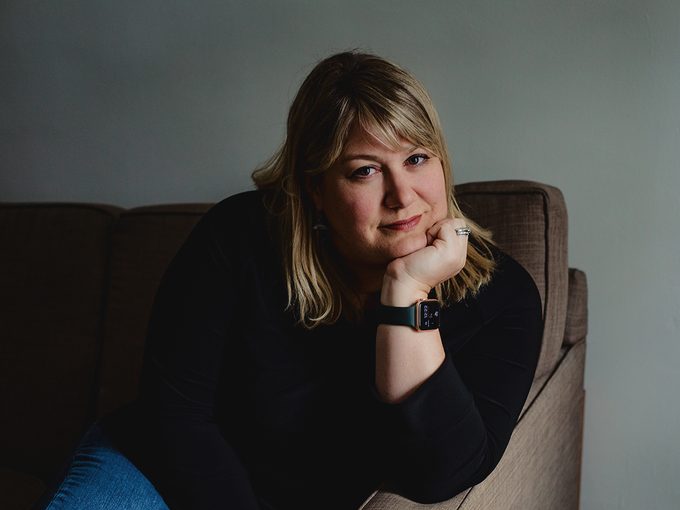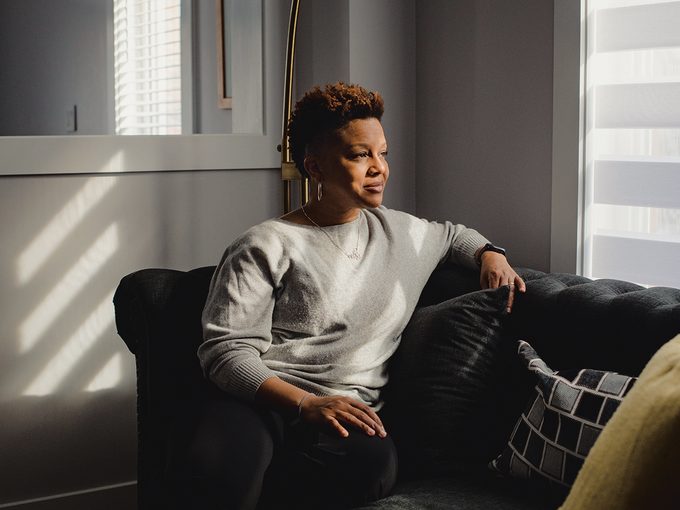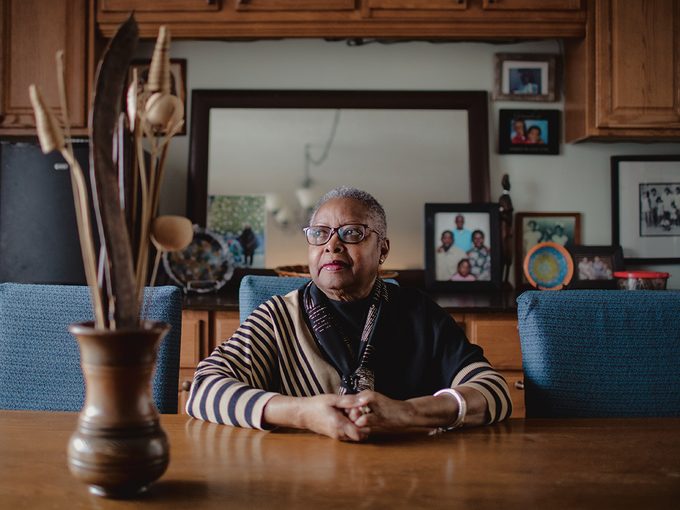3 Women Tell Us What Happened When They Had a Stroke

Here are the warning signs and prevention tips they wish more people knew about.
Every year, more than 100,000 Canadians have a stroke, and around half of them are women.
Most stroke sufferers will experience what’s called an ischemic stroke, where a clot blocks blood flow to a part of the brain. When the cells on the other side of that clot stop getting oxygen and nutrients, they die, which causes brain damage and lasting symptoms like memory loss or paralysis. Because each side of the brain controls the opposite side of the body, people who have a stroke in the right side of their brain will often be paralyzed on their left side (and vice versa).
Others will have a hemorrhagic stroke, which happens when a weakened blood vessel in the brain leaks or bursts, flooding the surrounding area with blood and causing the cells there to die.
Finally, a mini-stroke (the medical term is a transient ischemic attack, or TIA) is when a clot temporarily blocks blood flow to the brain before breaking up on its own. It causes symptoms for an average of 15 minutes and resolves within 24 hours, with minor damage. But it’s often a “warning shot” that you’ll have another stroke within the next few days, says Michael Hill, a neurologist at the University of Calgary and Foothills Hospital and a prominent stroke researcher. For that reason, it definitely warrants an ER trip.
The most important thing to know, says Hill, is that “the main risk factors for stroke are one: hypertension, two: hypertension and three: hypertension.”
He explains that blood clots usually develop from uncontrolled high blood pressure—also known as hypertension—combined with additional factors (such as high cholesterol or smoking). When the pressure of the blood flowing within your arteries is higher than it should be, it damages the walls of those arteries, and your body dispatches white blood cells to the site. When that damage is combined with high cholesterol floating by, sticking to the white blood cells, it results in the accumulation of plaque on the artery wall. The plaque may cause clots, and a big clot can completely block the artery it’s in, or float to another part of your body and cause trouble there. If it blocks the blood flow to your heart, that’s a heart attack. If it impedes the blood flow to your brain, that’s a stroke.
This is why it’s so important to check your blood pressure periodically. Both women and men should aim for a reading under about 120/80 mm Hg.
The risk of stroke is also higher if you are older than 55; if you have a family history of stroke; if you are obese; or if you have diabetes, high blood cholesterol or atrial fibrillation. People living in poverty (who are more likely to be women than men), some members of racialized communities and Indigenous people, and people living in rural or remote areas are also more likely to have risk factors for stroke, and are less likely to have access to consistent or comprehensive management of those health issues.
Recently, newer research has revealed heightened stroke risks that are specific to women: Having endometriosis, taking estrogen-containing birth control, being pregnant and being on hormone replacement therapy all slightly increase the likelihood of stroke. If you experienced pre-eclampsia during a pregnancy, your risk of a stroke later in life doubles.
But while some of those risk factors might be out of our control, there is plenty that women can do to lower their risk of stroke, including quitting smoking, getting active, eating more fruit and vegetables and keeping blood pressure in check.
Some good news: Over the past decade, medications and treatments for strokes have improved dramatically, and considerably more Canadians who suffer a stroke now survive. One newer, game-changing treatment is called endovascular thrombectomy (EVT), in which doctors go into the bloodstream after the clot has blocked the blood flow with a small flexible tube and physically pull the clot out. At Foothills, which was one of the first hospitals to test and pioneer this extraction procedure, Hill worked on a study finding that, for very large, serious strokes, EVT has radically improved patient quality of life and cut death rates in half.
“It has transformed care for that group of people,” says Patrice Lindsay, director of health systems at the Heart and Stroke Foundation of Canada.
But these new meds and interventions work best if people seek help within minutes of having a stroke. “Statistically, we can show that every 10 minutes makes a difference,” says Hill. “Coming in early can make the difference between walking out of the hospital two days later or being in long-term care, paralyzed.”

Carla Hindman
Communications professional and 44-year-old mother of three in Toronto
I was only 41 when I had a stroke. I was at my office, and at around 1 p.m. I went to the bathroom. When I went to wash my hands, I looked at myself in the mirror and I couldn’t see properly. I thought, This is really weird. When I finished washing my hands and walked back to my desk, I put my head down and started to cry. A colleague beside me was like, “What’s going on?” And I said, “Something’s wrong with my eyes.” But then I said, “I think I’m having an ocular migraine”—I had had one before. I didn’t know that vision changes were also a sign of stroke.
My colleagues decided to call my husband, Matt, who worked across the street. We jumped in a cab together to go to our doctor’s office, and by the time we got there, my face was drooping, I was slurring and I had weakness in my left side. Matt was thinking, Oh my God, this looks like a stroke. Since we were in front of my family doctor’s office, he decided to take me inside instead of wasting more time going all the way back downtown to the ER—he thought it would be better to get medical advice as soon as possible. But they took one look at me at the doctor’s office and called 911.
When we were waiting for the ambulance, Matt told me to raise my hands. I raised only the right one, and he said, “Both of them!” I yelled back at him, “I am raising both of them!” but my left arm was dead at my side—I just didn’t know it.
I don’t remember anything after that until midnight. But I had left the doctor’s office in an ambulance, and they had assessed me, given me clot-busting medication and put me in the ICU. My mom had flown in from Ottawa to be with me, and Matt had gone home to be with our three kids. The nurses were coming in every once in a while, showing me flashcards, asking me what the pictures were. My mom said that at midnight it was like a switch flipped, and I was back to normal.
At the hospital, they found a hole in my heart, which I had no idea was there. They said that this was what caused the stroke—those holes can allow blood clots to travel to the brain instead of the lungs, where they would normally go. A year later, I had a procedure to repair it, and now my risk of a stroke is as low as an average person’s.
I was extremely, extremely lucky: I didn’t have any lasting physical deficiencies after the stroke. But I do have a few issues with short-term memory still, and sometimes I have trouble coming up with the word I want. And I was exhausted afterward—I was off work for a month and then had to do a staggered re-entry after that.
I didn’t know that people my age could have strokes, but now I have met so many people who have had them in their 40s. It happens all the time. I think everyone should know what the signs of a stroke are and that vision changes are one of them. If more people knew the signs, and that young people can have strokes, they might feel empowered to call 911 in situations like mine, and a lot more people could get the help they need faster.

Kathy Isaac
Cybersecurity executive and 47-year-old married mother of two in Ajax, Ontario
I had a stroke two years ago while I was in the ICU, hospitalized for COVID. After about two days, I woke up with extreme nausea, and I was dizzy and vomiting for days. But my doctors didn’t realize what was happening, even after my left hand started to feel strange and heavy. Eventually, I realized I couldn’t hold my fork in that hand.
A week later, when a physiotherapist came to prepare me to go home, she was the one who noticed the signs of stroke. They did a brain scan, and a doctor came the day before I was supposed to leave and said, “I have bad news—you’ve had a stroke.” I thought he had the wrong person. I actually said to him, “No, I’m Kathy.”
In my head, I’m thinking, I’m 45 years old. Strokes are for older people. I’m better, I’m going home.
Even after I realized something had happened, I still felt like, if I’ve had a stroke, what does that mean? They started to talk to me about neuroplasticity, and they explained that the best window for recovery is the first six months.
So I wasn’t wasting any time. I started walking in my hospital room while I was still attached to oxygen. Then I did outpatient therapy: physical therapy, occupational therapy and a little bit of speech therapy, too. I had a singular goal: I wanted to go in one direction, to make progress. I did everything they asked. And I did well—I hit the physical milestones by about three months out.
But it still all felt so heavy. I had a meltdown one day with my physiotherapist and just cried. Eventually, I was connected to the Heart and Stroke Foundation and the March of Dimes. I was in a young stroke survivors’ group for a long time.
Just before I went into the hospital for COVID, I had graduated from Ivey Business School in London, Ontario, with my MBA. It was hard, really hard—I did it while I was working as an executive, and as a wife and mother. I thought about quitting. But the motto at Ivey was “trust the process.” And I decided, no, I’m gonna tough it out.
That was an important life lesson. When I went to rehab, I knew to just put in the work, and trust the process. I’m a born-again Christian and I do believe, like the Bible says, that all things work together for good. To me, the MBA prepared me.
I’m a few years out from the stroke now. My mobility is really good, and work is going well, too—I think I perform very well. But I have to work every day to not regress—I walk or use my spin bike. And I’m not the same. My balance can be a little wonky, I can’t handle noisy situations and I have more anxiety. I still have precision issues in my left hand because the message from the brain to my left hand is delayed. If I type with both hands, the right hand will be fine and the left hand will be behind.
One of the biggest challenges I’ve had is friends and acquaintances thinking I’m all better. I’m not looking for sympathy, but I need people to understand that I’m not 100 percent. Even when I park in a disabled parking spot—which I need to do—I’ve been confronted by strangers when I get out of my car. Because I don’t use a cane or a walker, I don’t get the understanding and help that I need.

Earle Hoyte
76-year-old retired church administrator, caregiver and grandmother in Toronto
One weekend I went on a short trip. After I got home, off the train, I said something to my granddaughter, and it felt like it wasn’t coming out right. But when I asked her if she could understand what I was saying, she said yes. And I also felt very tired, so I just went to bed.
In the morning, my tongue felt very heavy, and when I went to put on my lipstick, my hand kept falling down. My son-in-law and daughter-in-law were there and they said, “You don’t sound well—we should take you to the hospital.” I knew I wasn’t fine; I felt different. But I didn’t know it was a stroke. I thought only old people had strokes and I was only 75.
And I didn’t realize what else was happening to me. At the hospital, the nurses recognized it immediately as stroke and pushed me through. The doctors did a lot of tests. But I didn’t realize the effect the stroke had on me until the doctor asked me to sign my name on a document. It was only then that I realized I couldn’t. I was just scribbling.
They told me my stroke was caused by atrial fibrillation—an irregular heartbeat. I didn’t know I had it before the stroke. They put me on blood thinners, and with atrial fibrillation, it’s quite easy to have another stroke. So I have to be quite careful, and take my tablets every day.
After I left the hospital, I was referred to the University Centre location of Toronto Rehab. Before I went, I didn’t know what to expect. I was scared. But everybody I met there was so warm to me—even the receptionist. They were very positive, and it helped very much.
I went there for three months, as an outpatient. We worked on the physical: I had to walk with a walker, and up and down stairs, and practice stepping over things. They focused on my balance a lot, too.
They also worked on my memory, because whenever I tried to speak, I had to think for a long time to remember what I wanted to say. And a speech therapist helped with my voice—I used to sing in the church choir, and I couldn’t sing anymore. My driver’s licence was suspended, and they worked on that with me. I even did a driving simulation at Toronto Rehab.
At one point, I didn’t want to go, because I was feeling depressed. They referred me to a social worker, and to the March of Dimes program for people with disabilities. Now I go several times a week. March of Dimes has a stroke textbook, too, that I wish I had had before, because it tells you what to expect, what questions to ask, who is going to see you and what each person will do for you.
I’ve improved a lot—I’m back to singing in the choir, and I’m able to be a caregiver to my elderly sister. But there are things I can’t do anymore, like baking or reaching items off the highest shelves. I had to completely rearrange my kitchen. Holding my arms down for so long, or holding something heavy—it’s too hard.
I wish everybody knew that if your body feels strange, seek help. You don’t know what it is—it could be anything. Especially if it’s something you haven’t experienced before. Don’t say, “Let me wait and see”—seek help immediately. That’s the key.




